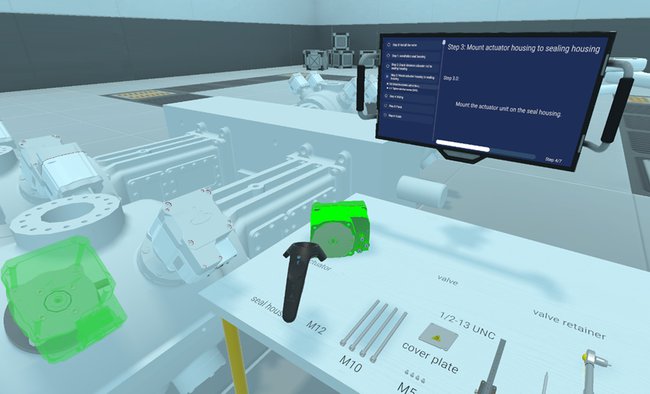Training Companies in Mixed Reality Use
Project with Higher Education Institutions and Industrial Companies Developed Training Tool for Employees

Virtual reality (VR) and augmented reality (AR) – often subsumed into mixed reality (MR) or extended reality (XR) – not only expand the possibilities of data visualisation but also allow for new forms of collaboration. In a common project, four higher education institutions and over 20 renowned (industrial) companies examine how to intuitively use these technologies to train employees.
Untapped Potential
“Although they might have already gained some insights in this respect, many companies do not know how they can use such technologies in a beneficial way, which advantages they entail, and how they can exploit their potential. In many industries that could benefit from them, mixed reality is, therefore, hardly used – if at all. In our project IMPACT-sXR, we seek to close this gap by developing a training and assistance concept that makes it easier for users to intuitively learn new working methods”, says Thomas Moser, head of the St. Pölten UAS’ Institute of Creative\Media/Technologies and scientific project lead of IMPACT-sXR.
The project developed new methods for the use of virtual reality (VR) and the computer-assisted extension of reality perception and augmented reality (AR). In other words: environments where the boundaries between the virtual and the real worlds are blurred. The researchers and companies tested those methods: for example, to train for activities in assembly and maintenance processes, or for quality assurance.
New Forms of Collaboration
The project team tested new forms of location-independent collaboration: for example, by enabling two people to work in the same VR room although they are in different locations in the real world, or by enabling somebody to remotely support another person at a different location in maintaining a machine.
To this end, the teams used real-time 3D in-depth information from real environments and visualisation of real-time production data that users can interact with.
The project also established new XR-assisted training and learning methods. “XR methods make it easier to implement training scenarios that are adaptive. They increase the measurability of learning success and make it possible to adapt trainings to changed circumstances faster. Through gamification, we can, thereby, integrate playful elements into the teaching of content”, says Moser.
Examples: from Industry Assembly and Underground Construction to Company Presentation
Almost all companies have contributed concrete case examples to the project, which were examined and further developed.
AUVA and the supermarket chain Spar joined forces to test augmented reality visualisation of ergonomically correct movement when lifting loads with an avatar. The companies Geodata and Wiener Linien GmbH & Co KG created new procedures to measure underground construction sites.
Other cases included changing industrial saw blades, assembling a compressor control or an engine, or introducing the company to new staff members during their onboarding.
Acceptance and Sustainability
In the project, the researchers teamed up with companies and their staff members. Together, they developed procedures to ensure that the newly developed technologies and working methods are met with acceptance.
Moreover, the project studied the benefits of XR solutions in enhancing sustainability, and energy and resource efficiency and their potential contribution to reducing the ecological footprint.
Large Network and Open Knowledge
The large network of project partners (23 partners from the industry and four higher education institutions) covered many use cases and ensured that the knowledge on using XR technologies is widely disseminated. The research results were made available to the public – unless they affected company-specific data or processes – and are therefore also accessible for companies that were not involved in the project.
The participating universities included FH Joanneum University of Applied Sciences, University of Applied Sciences Upper Austria, TU Wien, and the St. Pölten UAS as the scientific project lead. The project was coordinated by the mechatronics cluster of ecoplus – the Lower Austrian business agency.
The company partners included: Geodata Group, Hoerbiger Wien GmbH, Umdasch Group Ventures GmbH, RHI Magnesita GmbH, Palfinger AG, Lenze SE [Germany], Otto Bock HealthCare Products GmbH, Wr. Linien GmbH & Co KG, Voestalpine Böhler Welding Group GmbH, ÖBB-Personenverkehr AG, Bosch Rexroth GmbH [Germany], ZKW Group GmbH, voestalpine Signaling Zeltweg GmbH, Trotec Laser GmbH, Framag Industrieanlagenbau GmbH, AUVA, Takeda Pharma Ges.m.b.H., AMS, Swietelsky AG, Siemens AG, Haumberger e.U. and Inventio GmbH.
Project IMPACT-sXR – Industrial Manufacturing Process and Collaboration Tools for Sustainable XR
